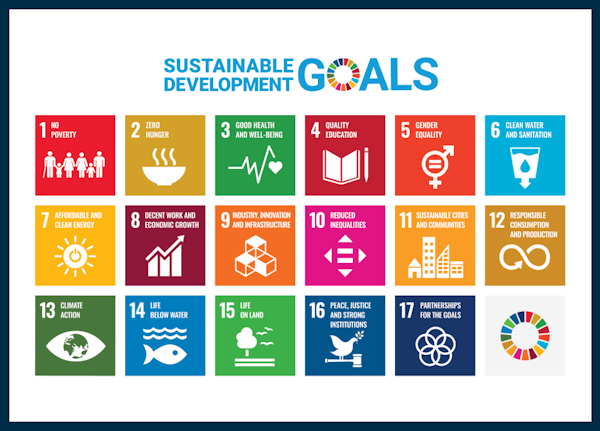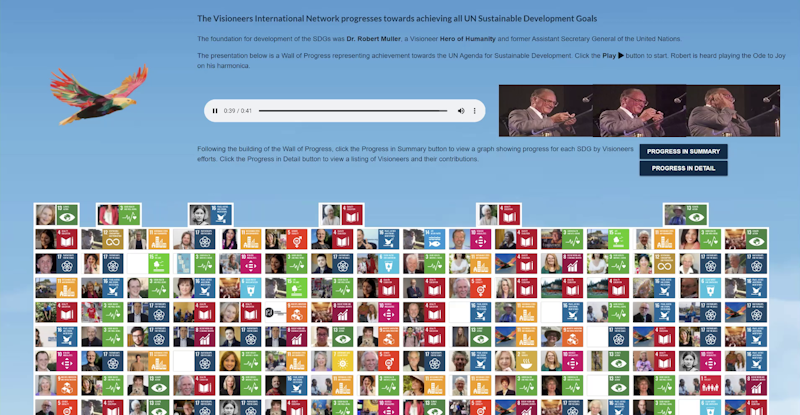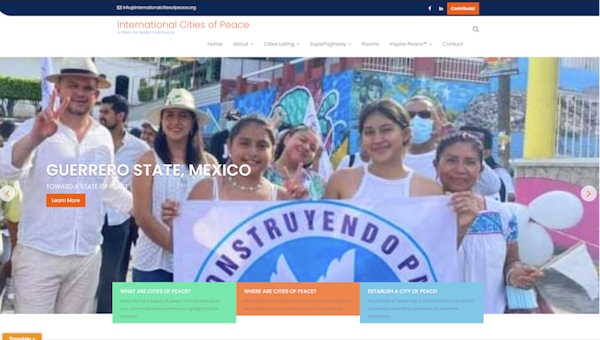GERRI: Hello everyone and especially hello to everyone listening to us around the world. So, good morning, good afternoon, good evening.
Here we go.
I'm Gerri Schwartz of the Visioneers International Network. I'm here with my partner Des Berghofer to welcome you to Episode 8 on our Journey of Extraordinary Wisdom. To use a phrase of our last wisdom keeper, Robert Muller: Can you imagine? He was always saying this. Can you imagine 1000 cities of peace in more than 100 countries?
Today we are about to be uplifted and inspired in order to act ourselves on this key issue, in order to join in waging peace, as we learn about the story, the purpose, and the mission of International Cities of Peace, an organization passionately bent on achieving this goal, as told by its Founding Director, Fred Arment.
In this episode, we will learn about a practical, on-the-ground response to the most important issue facing humanity today, a global movement, a culture of peace, not just the absence of war. This is what we need to create a golden peace.
DESMOND: Yes, a golden peace, because without peace we cannot solve the mega crisis of the other existential problems facing us. In our episode today we will hear of a goal to establish 1000 cities of peace in more than 100 countries, with peace teams actively engaged in waging peace to create communities where people are safe, prosperous, and thriving, in a life of quality.
Two key questions arise:
- Why cities?
- How do we achieve this magnificent goal?
Fred will answer these questions. Fred Arment, Visioneers Visionary Leader, is a person who wears many hats. He lives in the USA. In 2009 he turned his talent as a successful businessman of a communications and strategic marketing company to found a number of non-profit initiatives. Among the most significant is International Cities of Peace, ICP, now on its way to achieving the goal of 1000 cities of peace in more than 100 countries. Fred will describe the strategy of International Cities of Peace.
So, let the story begin. Listen with an open heart and an engaged mind and be inspired by the action in the images you see. Here's Fred.
FRED: As Chair of the Board for International Cities of Peace, I bring good wishes from the leaders and peace teams of nearly 400 member cities of peace in 70 countries on six continents. The Visioneers International Network is evidentiary proof that beneath the violent headlines there is a rising of peacemakers, a gathering of the like-minded, an intellectual, spiritual, physical changing of the guard and evolution of humankind. What we are evolving toward, humanekind.
Fourteen years ago, when we started International Cities of Peace, there was an epiphany, an awareness, a vision into hope for the world. The idea of a city of peace is an ancient thought, a Jungian archetype for what humanity seeks: peace in the world, peace in our countries, peace in our cities, and peace in our hearts.
International Cities of Peace did not originate the idea of a city of peace. It was created by early humans, those who first decided that our basic drive to survive would be better served if we could thrive more than survive, if we could elevate our consciousness to an advanced reality.
The city of peace ideal was born thousands of years ago as a prototype for conscious living, and today International Cities of Peace provides a means, a platform, a way forward that lives in our hearts and provides the way to achieve the world dream of peace that is common to all of humanity.
GERRI: What magnificent images of waging peace in action!
Now to continue, let's go to the wisdom of global citizen, Robert Muller. He was called the Prophet of Hope at the United Nations. But for Robert, and here's the key to everything, hope was more than a feeling. It was a strategy for action, and that is exactly a strategy for action that we present today, by an organization in the full flood of achieving its goal.
For Robert, everything begins with a dream, and what we are about to see is the dream of creating a culture of peace. Now this dream is congruent with the wisdom of all the wisdom keepers that we've heard so far, and especially with the vision of the Visioneers Golden Peace.
So, here is what the Golden Peace actually looks like.

Humanity's Golden Peace

Humanity’s Golden Peace is the safe harbour we need to deliver positive, creative solutions to the existential crises we face.
The overarching statement about the meaning of Golden Peace includes the absence of war, and much more.
It includes creating a safe harbour where:
- Maternity hospitals are safe for mother and child.
- Schools from nurseries and kindergarten to grade 12 to universities are places where students feel safe to pursue learning and make friendships and where bullying of any kind is unacceptable.
- Workplaces are safe and free of discrimination.
- Justice, diversity, truth telling and following the rule of law are honoured.
- The disabled, the elderly, and the poor are treated with respect and nurtured to contribute.
- Governments are chosen by a free and protected vote of the people.
- Human rights, including the rights of women, Indigenous people, and people of different beliefs, races, and sexual orientations are respected.
- Looking after the Earth, the air, the water, ourselves, each other and ensuring that all living creatures are respected is the prime underlying requirements of peace everywhere.
DESMOND: Let’s return for a moment to Robert who spoke of his dream for a golden peace. He talks of the United Nations as a meta biological organization of the human species. And the United Nations has set out the details of the golden peace in 17 Sustainable Development Goals.

The Visioneers are showing support for the United Nations goals by creating a wall of stories linked to the goals by the color of the bricks, with Robert playing Ode to Joy on his harmonica as backdrop.

International Cities of Peace is one of the bricks on the wall of stories.

https://internationalcitiesofpeace.org
Here's Fred to explain and expand the concept of International Cities of Peace in building a culture of peace.
FRED: The Covid 19 pandemic has given us a wake up call. It is one more way we have learned, along with many other potential existential threats, that we must accelerate change in the way we organize for peace. Just as technology and industry are changing at a rapid pace, peace must evolve quickly and must change before our challenges overwhelm us. Peace work must evolve quickly, we must find the best strategies we can, no longer simply relying on nation states, whose essential mission is to compete with other nation states for resources and dominance.
And we can no longer rely on telling people how to find peace. The world is too diverse, cultures have individual natures. Our strategies for achieving global peace are worn out, and as we know, time is short to achieve the unity that is essential for cooperative success.
That's where Cities of Peace comes in. Villages, towns, and cities are the organizing units closest to our family units. The objectives of our communities are very straightforward: keep our families safe, make sure our children are not hungry and have a roof over their heads, provide the highest quality of life such as clean water and education, so that each individual can find their purpose.
This is how International Cities of Peace defines peace: safety, prosperity, and quality of life for each and every person in the community. These are the consensus values of peace around the globe. Peace is about freedom from harm, freedom from want, freedom from oppression.
Peace building at the community level has immediate impact. Needs are known, solutions come from cooperation between all sectors of society. Peace building means supporting schools and health clinics. It means taking care of orphans and those at risk, including refugees and those affected by war, poverty, and hunger. It means teaching nonviolence and the golden rule.
Imagine 1000 cities of peace each with teams of citizens in situ or in the situation on the ground where they know the needs of the community and can find unique solutions. Peace and community depends on citizens that live in the community. Their future is theirs to decide. The old technology of peace building is failing. Much of the billions of dollars telling people how to find peace has been wasted. When the money is spent, when the outside volunteers are gone, the community is often left with a sense of abandonment. The truth is, the people inmevery community must carry on, they must continue the work for peace when the eyes of the world are no longer on them. They must be inspired and fully responsible for their own community, their own future.
How can we fully embrace this essential fact, that it is up to each community to find peace in their own way? How do we organize a purposeful world without dominating?
As the ancient adage teaches, give a person a fish feed them for a day, teach them how to fish and you will feed them for a lifetime. Our greatest challenge as peacemakers is how can we in the age of Covid teach the world in effect to fish? How can we decentralize the dynamic of community and meet the challenges of providing safety, prosperity, and quality of life for everyone around the world. How can we ensure a sustainable peace?
I'm pleased to report that International Cities of Peace is fully embracing a decentralized strategy. We have turned the usual dynamic of centralized control on its head. Instead of a top-down bureaucracy, we identify and encourage community leaders to build volunteer teams to find solutions to the basic needs that only those living in the community can really know. We have achieved success in many areas. We've been recognized with special consultative status with the United Nations body for NGOs ECOSOC.
Peace in our view is not just a hope, it's a community right. Hundreds of international cities of peace in situ. Leaders on the ground understand the social, economic, and often the political factors that affect the lives of citizens in their communities. They understand the needs, and are in the best position to know solutions. The challenge is to find community leaders that are vetted and trusted, that have a track record of practical community work. It is a two-way partnership of mutual respect and action.
International Cities of Peace has many successful case studies on how this two-way dynamic works. For instance, early in this difficult year as Covid 19 began to ravage the world, one city of peace asked if they could help other less advantaged cities of peace during the crisis. In Nanjing, China, the city of peace team leaders inquired if there was a city-to-city program where the people of China could provide resources to stop the spread.
Upon a suggestion, it was decided that there would soon be a great need in Africa to get in front of the virus before it devastated that continent of 1.2 billion people. As a decentralized NGO, we were immediately in contact with trusted leaders in Nigeria, Uganda the Congo, Kenya, many other at-risk communities. Within days, city of peace leaders in Africa sent their unique solutions to stop the spread of Covid 19. These solutions ranged from providing thermometers and soap, to installing central washing stations, and providing rice to rural families that would soon be in lockdown.
Nanjing mini-grants quickly began to flow to over thirty cities of peace communities through leaders that had been vetted after years of volunteer work. The city-to-city mini-grant program was a major success. It was fast, it was flexible, it was measurable, and without corruption.
This is the success of International Cities of Peace mini grants from Nanjing. It is a harbinger of the way NGOs must operate in the future. In situ, or on-the-ground peace leaders in the community suggested how the funds could be used to make the most positive difference. Best of all, after the funding for the mini grants ran out, the leaders kept on working to inform and educate about Covid 19. They volunteered in ways that motivated more volunteers and extended the compassionate reach of those in Nanjing, even to this day. Giving those leaders a fish was not the point. They knew how and where to fish. We respected their understanding of community. We simply helped them help themselves. Our leaders were building the infrastructure of peace, safety, prosperity and quality of life
for all. That is how peace could be won. Nanjing 's extraordinary city-to-city program was definitely a harbinger of the future and how International Cities of Peace operates on the ground.
As humankind evolves to the next level of empathy and compassion, the role of peacemakers must also evolve. At the core of peace building is respect for others. Covid 19 has shown the necessity of organizing our world to face the challenges and danger the future must surely bring. A great sage who lived in China 2000 years ago perhaps said it best: Consideration for others, taught Confucius, is the basis of a good life, a good society. Consideration is the lasting basis of peace. Respect is the basis of trust, and trust is the basis of building a lasting culture of peace.
I am absolutely certain that the peace makers on this call are choosing a higher purpose, a more noble role in the attainment of global peace. Safety, prosperity and quality of life are the consensus values of community peace in your community and around the world. Our teachers, our first responders, our civic leaders, our technologists and innovators are all on the job.
Many more communities around the globe are embracing the ancient ideal of becoming a true and historic city of peace. We are headed toward 1000 cities of peace in 100 countries by year 2025. I hope you'll help. It is a vision that is attainable, sustainable, practical, and evolutionary.
GERRI: Fred has explained the concept of the strategy of using the city as an organizational unit. Now this is an ancient concept as seen in the wisdom of Lao Tzu from the sixth century BCE. Des, would you read this.


If there is to be peace in the WORLD,
Then there must be peace in the NATIONS.
If there is to be peace in the NATIONS,
Then there must be peace in the CITIES.
If there is to be peace in the CITIES,
Then there must be peace between NEIGHBOURS.
If there is to be peace between NEIGHBOURS,
Then there must be peace in the HOMES.
If there is to be peace in the HOMES,
Then there must be peace in the HEART.
Lao Tzu
604 BCE
DESMOND: So, in this ancient wisdom we see the way for people to build a peaceful world, working upwards from peace in individual hearts in the homes, through neighbourhoods, to cities, then to nations, and to the world. Within this framework, the city is the organizational unit in which people can have an impact on the nation.
GERRI: Fred expands the idea of creating a culture of peace by including the concept of respect as a central tenet of an evolved humanity. This idea and the work of the International Cities of Peace takes us back to the wisdom expressed in all our previous episodes.
This is the global mind change called for by Willis Harman, as we move towards planetary consciousness envisioned by Ervin Laszlo, with the living earth and value for all life called for by Jane Goodall, and where the equal partnership of women and men envisioned by Anne Baring, as evolving possible humans imagined by Jean Houston, and as the attainment of an Age of Consciousness predicted by Bill Halal. in the decade of the 2020s, so fulfilling the dream of Robert Muller.
The task ahead is to support International Cities of Peace, and join them in creating 1000 cities of peace, 10,000 villages, 100,000 hamlets and one million neighborhoods, all with open-hearted, strong-minded evolved humanity, living in communities where a culture of peace thrives.
To accomplish this task, we need heroes and heroines. We need thousands of dreamers, thousands of leaders. We need elders, mentors, youth, children, even children. We need all of us.
DESMOND: Thank you to Fred and all the leaders and members of the 400 cities of peace so far created as we wage peace and build the Visioneers Golden Peace.
Here is Fred again to tell you how to create your own City of Peace and help change the world.
FRED: Now the next thing, you know, that's what we came here to hear, how to establish a City of Peace, what is the process, and the process is very straightforward. It's intended to be a very simple five steps, but it's very profound, the people who go through this process have always said that this has created a new life, a new structure for how they live and how they work in their community.
First is you get signatures on a letter of intent, in other words, you create a peace team, then you write up vision, mission and goal statements for the city, and this is where people have to really think about how they work for peace in community, and this is what separates all the cities of peace. Their vision, their mission and goals, it's all unique, every single one of them is different. So, they send photos and captions of local events and they submit a photo of the leader so that we know more about them.
And they write a peace legacy for their community, what are the challenges, what are their solutions, and we're going to be able to put this online so that people can use the International Cities of Peace website internationalcitiesofpeace.org as the way to communicate, not only to people outside but also with people within, and so we're working on that right now.
This is the letter of intent, which is a document that focuses on the UNESCO tenets of a culture of peace, and people fill in their municipality and they get signatures, there's a couple of signature pages attached to it. And we have the option of having a peace proclamation by the city mayor, the city commission, the chief of the village. They can proclaim an International City of Peace. It's not required, some places it's difficult to get the government and the grassroots organizations to work together, so this is something that can be an objective, or it can be accomplished immediately.
And we have several dreams: The first is to have safety prosperity and quality of life, the consensus values of peace, become the goal of humanity. Number two, stop regional conflicts at the local level
before they metastasize into the region, into the world. And number three, building the infrastructure of peace, the roads and bridges through which peace may travel.
GERRI: So, we've been on this journey, and now to anchor these thoughts and images in your imagination, listen to Tatiana Speed's beautiful song of peace called Caravan.
And you will hear the same message in Episodes 15 and 16 of the Visioneers Audio Theatre, also released today, where the story moves to the creation of a worldwide movement of peace called the Congress of the Global Mind. Be sure to listen.
And now, here is Tatiana and her beautiful song of peace, Caravan
TATIANA:
Peace is coming, I'm just letting you know. Hearts are blooming all around the world,
Brotherhood is coming, I'm just letting you know. Peace like a flag unfurled,
As we join the caravan to the promised land, the home that we share deep in our hearts,
And we join caravan singing an ancient song not forgotten
Hallelujah
Hallelujah
Come with me my brother, let's travel the distance into the light of a calm new day,
We are so beautiful, so many different colors. Listen our hearts know the way.
As we join the caravan heading to the promised land that we share deep in our heart.
We join caravan singing an ancient song not forgotten.
Hallelujah
Peace is coming, I'm just letting you know. Hearts are blooming all around the world.
